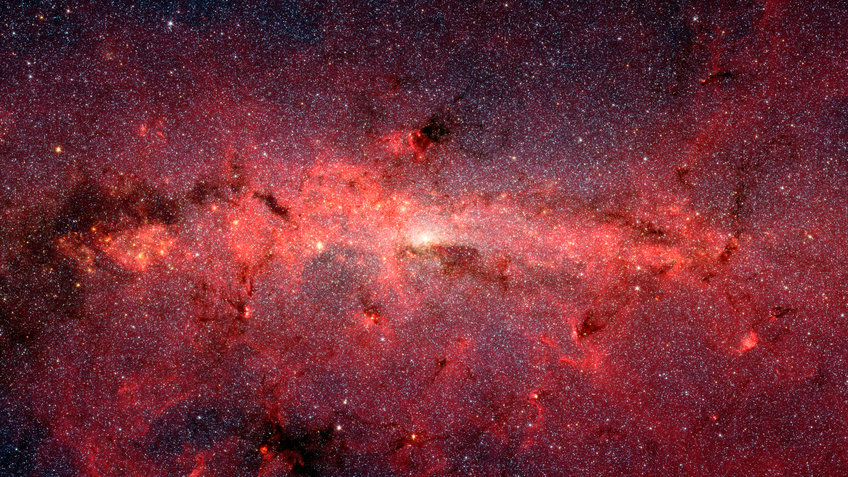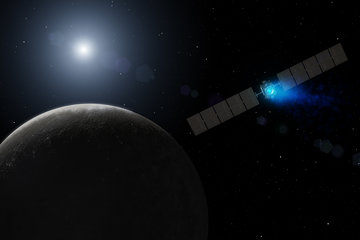Encounter of generations in the heart of the Galaxy
Astronomers discover a previously unknown population of stars near the centre of the Milky Way
The centre of our home galaxy is one of the regions richest in stars in the known Universe. Within this region, scientists have now identified a previously unknown, ancient stellar population with surprising properties. An international team of astronomers, with significant participation from the Max Planck Institute for Astronomy, has identified the origin of these stars to be a globular cluster within our galaxy, which moved to the centre of the Milky Way long ago.

On clear and dark nights it is still visible – the milky white, diffuse band of the Milky Way across the night sky. Since the invention of the telescope, scientists have known that this band consists of countless stars. Today, we understand that our home galaxy is mainly a large flat disc of hundreds of billions of stars, surrounded by dust and gas, and it is rotating around its centre.
About 25,000 light years away from Earth, located in the constellation of Sagittarius, lies the centre of the Milky Way. This so-called Galactic Centre was only discovered in the last century and has been the subject of astronomical research ever since.
In the innermost centre of the Milky Way rests an extremely massive black hole. It is surrounded by one of the densest agglomerations of stars in the known Universe – a so-called "Nuclear Star Cluster" (NSC). Astronomers today assume that there are around 20 million stars in the innermost 26 light years of the Galaxy.
However, it is not visible at all without special equipment, because there are numerous dust clouds between us and the Galactic Centre that obscure the visible light. It therefore appears darker than other parts of the Milky Way. Only observations at much shorter or longer wavelengths such as infrared light reveal the structure of this region of the sky, which is actually much more massive than other regions of the galaxy.
The Milky Way is by no means unique, and astronomers now believe that most spiral galaxies could contain both a central black hole and a nuclear star cluster. However, the nuclear star cluster within the Milky Way is the only place where astronomers can resolve individual stars because of its relatively close distance, making it an ideal laboratory for studying the properties of these huge stellar clusters.
This is why astronomers led by Anja Feldmeier-Krause from the European Southern Observatory and Nadine Neumayer from the Max Planck Institute for Astronomy in Heidelberg used special instruments at the Very Large Telescope in Chile to observe this unique region. In a recently published study, they analysed about 700 stars and not only examined their brightness and colour, but were also able to draw conclusions about their motions and speeds, but also about their chemical structure. These observations form the basis for a number of important discoveries about this so far unexplored part of the galaxy.
The chemical composition of a star is an important indicator in astronomy, as it tells us something about its age. Metallicity – the abundance of heavier elements than hydrogen and helium – is an important quantity. This is because all other elements can only form in those very stars. Therefore, if a star contains a large number of heavy elements such as oxygen, carbon or iron, this means that it must have formed from the remains of a precursor star and is therefore relatively young. Conversely, a low metallicity indicates a very old star, which formed in the early days of the Universe, when there were hardly any heavy elements present in the Cosmos. The metallicity is therefore a direct indication of the age of the respective star and therefore of great importance for astronomers.
In analysing these observations, an international team of researchers led by Tuan Do from the University of California, Los Angeles, and including Nadine Neumayer and Manuel Arca Sedda, both working in the Collaborative Research Centre SFB 881 at the Centre for Astronomy at the University of Heidelberg, has now discovered a previously unknown population of stars within the nuclear star cluster. While the majority of stars in the central region of the Milky Way have higher metallicities than the Sun, the scientists identified a group of stars that contained significantly less heavy elements. In addition, these stars are characterised by a common, higher velocity than that of the surrounding stars, and their direction of motion may be slightly tilted in relation to the galactic plane. The properties of these stars, which account for about 7% of all stars in the nuclear star cluster, are surprisingly similar. It is therefore obvious that these stars have a common origin. But how did they reach the innermost part of the galaxy?
An answer to this question may lie in the formation of a nuclear star cluster: according to a commonly accepted theory, they could at least partly have formed by collisions of several clusters, i.e. spatially denser collections of stars of similar ages, within a galaxy. Held together by the mutual gravitational pull, they move jointly through a bath of surrounding field stars. Stellar clusters exist in all known galaxies. Due to the phenomenon of dynamic friction, a gravitational effect of the surrounding matter, the clusters lose speed on their orbits and thus drift towards the Galactic Centre. At this point, they merge with other clusters and form the much larger nuclear star clusters. It is possible that the newly discovered population is a remnant of such an older group of stars.

To test this theory, the scientists used powerful computer simulations. They calculated a virtual system consisting of many individual objects, mapping the innermost 300 light years of the Milky Way. It includes the nuclear star cluster and the central black hole, as well as a massive star cluster with about 1 million solar masses, which at the beginning of the simulation was about 160 light years from the centre of the galaxy. “Among other things, our goal was to find out how long ago such a stellar cluster could have entered the region around the Galactic Centre and where it originally came from,” explains Arca Sedda.
When a stellar cluster falls towards the Galactic Centre, the gravitational interactions with its environment cause stars to be ejected from the cluster. Once it reaches the innermost part of the Galaxy, it dissolves within a relatively short timescale and its stars become largely indistinguishable from the rest of the stars in its new environment.
Since the members of the newly discovered stellar population still have some very characteristic similarities despite their dispersal, astronomers suspect a common origin of these stars outside the nuclear star cluster. The simulations now suggest that they have entered the central area within the recent 3 to a maximum of 5 billion years.
But where does the stellar cluster originally come from? There are several possibilities. The scientists have investigated the two most probable ones in their publication: firstly, the stars in a cluster may have come from regions further out in the Milky Way itself, from where they migrated to the centre of the galaxy. Another possibility is also the entry of a dwarf galaxy from around the Milky Way. The remaining galactic core or a large star cluster of this dwarf galaxy could have made it to the Galactic Centre. The scientists investigated both scenarios in their simulation.
“Our results indicate that an infall of a rather nearby stellar cluster from the Milky Way itself is more likely,” explains Neumayer. It was probably originally formed about 10,000 to 16,000 light years away.
To support this hypothesis, the astronomers also compared the observed properties of the newly discovered stellar population with the ones of old globular clusters in the Milky Way and those that entered our Milky Way together with dwarf galaxies. They found that the properties of the newly discovered central stars matched those of globular clusters in the Milky Way much better. The calculated distances of the preceding stellar clusters also correspond well with the distances of those that have been known for a while already. “Although an extragalactic origin of the stars cannot be completely ruled out, it is rather unlikely,” Arca Sedda concludes. “This is an additional sign that the central nuclear star cluster in the galaxy is at least partly the result of the impact of smaller clusters.”
RH / MN













